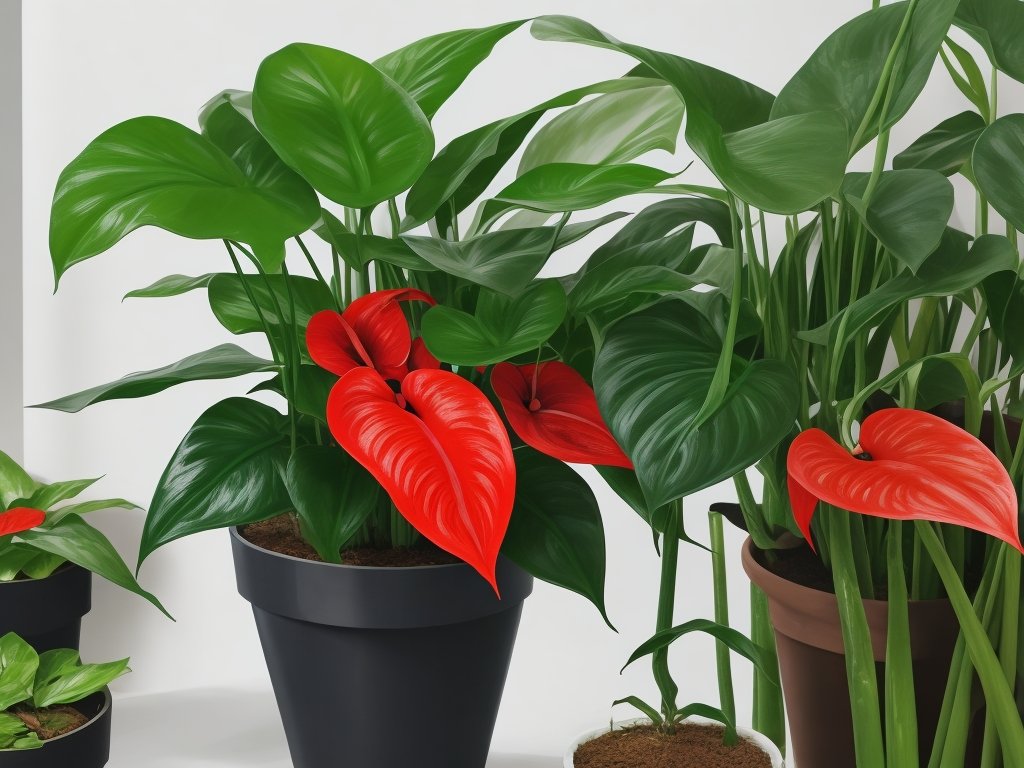Anthurium Leaf Issues: Troubleshooting Tips and Tricks
Key Takeaways:
- Yellowing leaves in anthurium plants could be a sign of overwatering or nutrient deficiency.
- Brown spots on anthurium leaves may be an indication of fungal or bacterial infections.
- Wilting and drooping leaves in anthuriums may suggest underwatering or excessive heat.
- Curling or distorted leaves in anthurium plants might be caused by pests or environmental stress.
Are your Anthurium plant leaves looking less than perfect?
Don’t worry, you’re not alone.
Many Anthurium owners, like yourself, face leaf issues with their beloved plants.
From yellowing and browning to curling, these problems can be frustrating and concerning.
But fear not, because I’m here to help! As an experienced plant enthusiast, I’ve encountered my fair share of Anthurium leaf issues, and through trial and error, I’ve learned how to identify the causes, prevent further damage, and treat these leaf issues effectively.
In this blog post, I’ll share my expertise and guide you through the Common Leaf Issues, their Causes, Prevention, and Treatment for your Anthurium plants.
So, let’s dive in and bring back that vibrant, healthy foliage!
| Issue | Description | Possible Causes | Solutions |
| Yellow Leaves | The leaves turn yellow and may eventually wither. | 1. Overwatering 2. Insufficient light 3. Nutrient deficiency | 1. Adjust watering schedule 2. Provide adequate light 3. Fertilize regularly |
| Brown Spots | Dark brown or black spots appear on the leaves. | 1. Fungal or bacterial infection 2. Overwatering 3. Chemical burn | 1. Remove affected leaves 2. Adjust watering frequency 3. Avoid leaf contact with chemicals |
| Yellow Veins | The veins of the leaves turn yellow while the rest of the leaf remains green. | 1. Nutrient deficiency (iron) 2. pH imbalance | 1. Apply iron-based fertilizer 2. Test and adjust the pH level |
| Wilting Leaves | The leaves become limp and droopy. | 1. Underwatering 2. Overwatering | 1. Water the plant thoroughly 2. Adjust watering frequency 3. Improve drainage |
Common Leaf Issues in Anthurium Plants
Anthurium plants can experience common leaf issues such as yellowing, browning, and curling. Let’s explore these problems and how to address them.
Leaf Yellowing in Anthurium Plants
Leaf yellowing in Anthurium plants can be caused by several factors. One common cause is overwatering, which leads to root rot and nutrient deficiencies.
Another cause is exposure to direct sunlight, which can scorch the leaves.
To prevent leaf yellowing, make sure to provide proper watering, avoid direct sunlight, and ensure the plant has balanced nutrients.
Leaf Browning in Anthurium Plants
Leaf browning in Anthurium plants can be caused by environmental factors, such as excessive sunlight or low humidity.
It can also be a sign of pest or disease infestation.
To prevent leaf browning, provide optimal environmental conditions, regularly check for pests and diseases, and ensure a balanced nutrient supply.
If you notice leaf browning, identify the underlying cause and treat it accordingly.
Leaf Curling in Anthurium Plants
Leaf curling in Anthurium plants can be caused by environmental factors, such as low humidity or excessive sunlight.
Pests and diseases, like spider mites or fungal infections, can also lead to leaf curling.
Nutrient deficiencies, especially in minerals like calcium or magnesium, may contribute to this issue as well.
To treat leaf curling, it’s important to identify the root cause and address it accordingly.
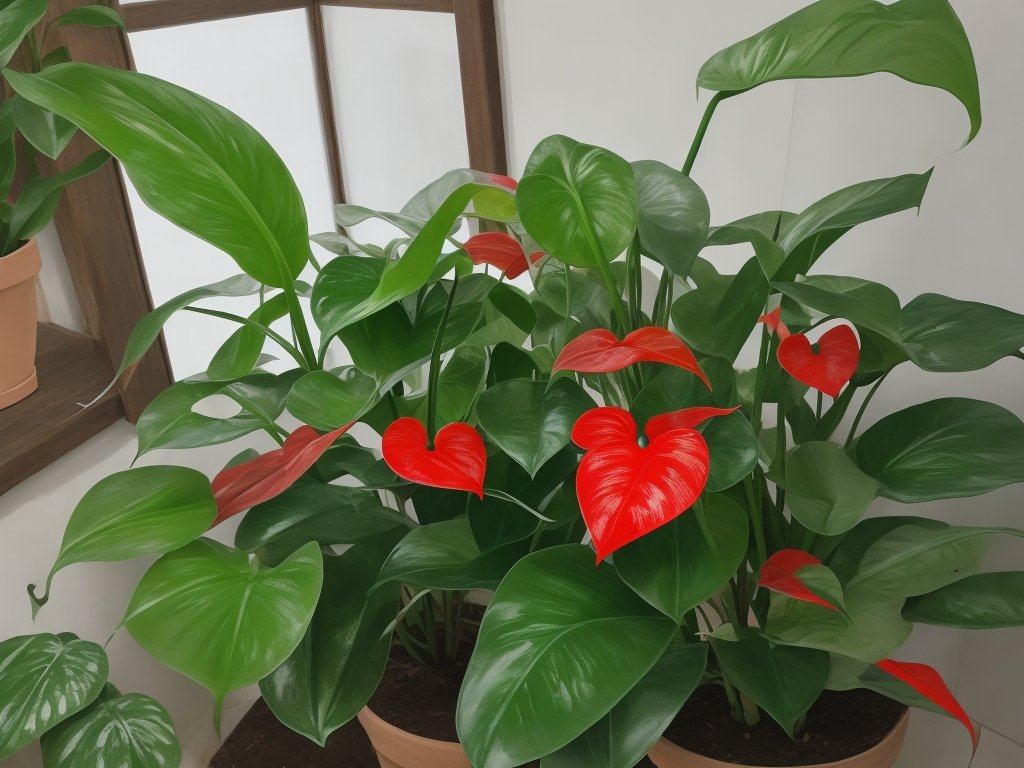
Causes of Anthurium Leaf Issues
Anthurium leaf issues can be caused by environmental factors, pests and diseases, and nutrient deficiencies.
Environmental Factors
Environmental factors can greatly impact the health of your Anthurium plant. Factors such as improper lighting, temperature extremes, and improper humidity levels can lead to leaf issues.
It’s important to provide your plant with optimal environmental conditions to prevent leaf problems.
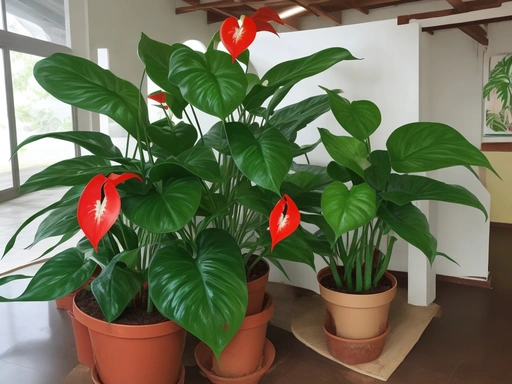
Pests and Diseases
Pests and diseases can wreak havoc on your Anthurium plant.
Common pests include aphids, mealybugs, and spider mites.
Diseases like root rot and bacterial blight can also cause issues.
Regularly inspect your plant for signs of pests or disease, and take prompt action to control and treat them.
Nutrient Deficiencies
Nutrient deficiencies in anthurium plants can manifest as various leaf issues.
Some common deficiencies include:
- Nitrogen deficiency: This can cause pale green or yellow leaves.
- Phosphorus deficiency: It leads to older leaves turning dark green or purple, and their tips may curl or become scorched.
- Potassium deficiency: It results in yellowing leaf margins and spots, as well as weak stems.
- Iron deficiency: This causes yellowing between veins, while the veins themselves remain green.
To address nutrient deficiencies, it’s important to provide a balanced nutrient supply through proper fertilization.
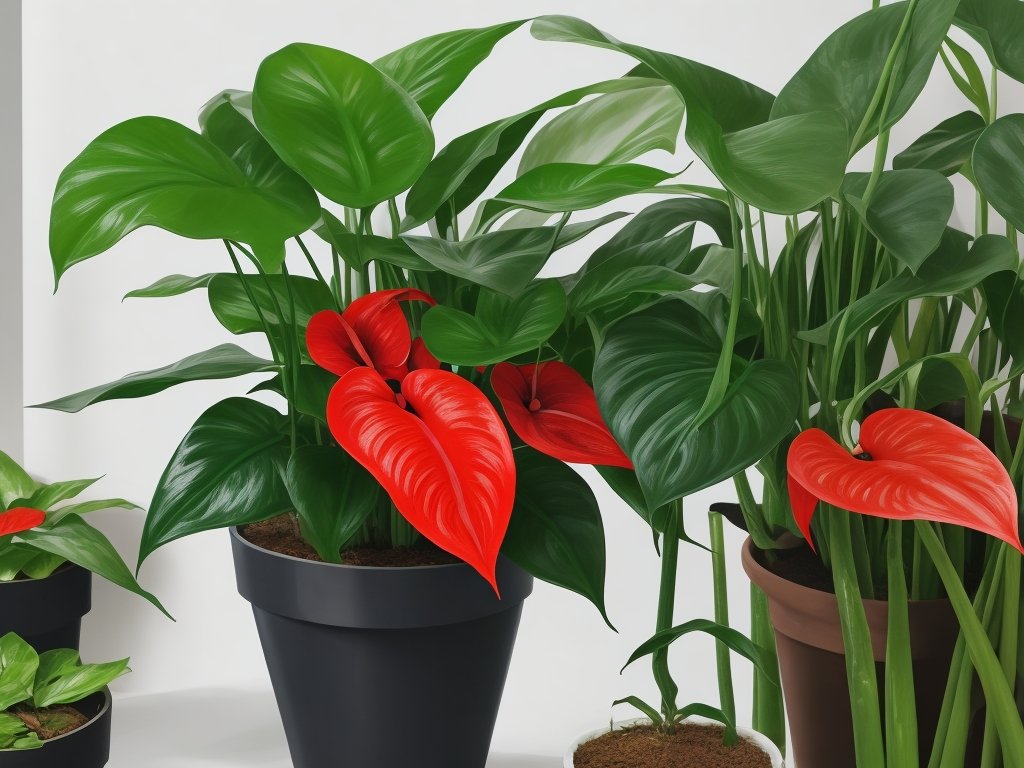
How to Prevent Anthurium Leaf Issues
To prevent Anthurium leaf issues, create optimal environmental conditions and properly water your plant.
Additionally, regularly control pests and diseases and provide a balanced nutrient supply.
Providing Optimal Environmental Conditions
To provide optimal environmental conditions for your Anthurium plant, you’ll want to ensure it has the right amount of light, temperature, and humidity. Place your plant in a location where it can receive bright, indirect light.
Avoid direct sunlight as it can lead to leaf burn.
Maintain a temperature between 70-85°F (21-29°C) during the day and slightly cooler at night. Anthurium plants prefer high humidity levels of around 60-70%.
Consider using a humidifier or placing your plant on a tray filled with water and pebbles to increase humidity.
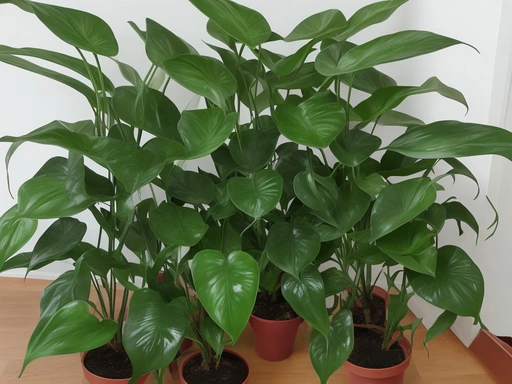
Proper Watering Techniques
Proper watering techniques are crucial for the health of your Anthurium plant. Here’s how to do it right:
- Water when the top inch of soil feels dry.
- Use room temperature water to avoid shocking the roots.
- Water thoroughly until water drains out of the bottom of the pot.
- Empty the excess water from the saucer to prevent root rot.
- Avoid overwatering, as it can lead to yellowing and root rot.
- Maintain a consistent watering schedule, but adjust based on the plant’s needs.
- Consider factors like temperature, humidity, and sunlight when determining watering frequency.
- Use well-draining soil to prevent waterlogged roots.
Regular Pest and Disease Control
Regular pest and disease control is crucial for maintaining healthy anthurium plants.
Here are some tips:
- Regularly inspect your plants for any signs of pests, such as aphids or mealybugs. If you notice any, treat them immediately with a suitable insecticide.
- Keep an eye out for signs of common diseases like leaf spot or root rot. Prune affected leaves and treat the plant with a fungicide to prevent further spread.
- Maintain good hygiene by regularly cleaning your plants, removing dead leaves, and disinfecting your tools. This helps prevent the accumulation of pests and diseases.
- Consider using natural remedies, such as neem oil or insecticidal soap, to control pests without relying solely on chemicals.
- Finally, ensure your plants receive proper care and nutrition. Healthy plants are less susceptible to pests and diseases, so provide them with the right amount of light, water, and nutrients to thrive.
By incorporating these practices into your routine, you can effectively control pests and diseases in your anthurium plants and keep them looking their best.
Balanced Nutrient Supply
Balanced nutrient supply is crucial for maintaining healthy anthurium plants.
I recommend using a balanced fertilizer specifically formulated for anthuriums.
It should have equal amounts of nitrogen, phosphorus, and potassium.
Additionally, providing micronutrients like iron, magnesium, and calcium will help prevent nutrient deficiencies.
Regularly fertilizing your anthurium plants according to the package instructions will ensure they receive the necessary nutrients for optimal growth and leaf health.
Treating Anthurium Leaf Issues
Now, let’s move on to how you can treat any issues with your Anthurium leaves and get them back to their healthy state.
Identifying the Root Cause
To identify the root cause of leaf issues in Anthurium plants, carefully examine the affected leaves. Look for signs of yellowing, browning, or curling.
Check for environmental factors like temperature, light, and humidity.
Inspect the plant for pests and diseases. Assess the nutrient levels in the soil.
By observing these factors, you can determine the underlying cause and take appropriate steps to treat it.
Natural Remedies for Leaf Yellowing
To address leaf yellowing in Anthurium plants, there are a few natural remedies you can try.
First, make sure the plant is receiving adequate sunlight without being exposed to direct, harsh sunlight.
Next, check the soil moisture levels and ensure you are not overwatering or underwatering the plant.
Additionally, consider adjusting the humidity levels around the plant by misting it regularly or placing a tray of water nearby.
Lastly, keep an eye out for any signs of pests or diseases, as they can also contribute to leaf yellowing.
Remedies for Leaf Browning
To remedy leaf browning in anthurium plants, start by ensuring they receive the right amount of sunlight. Avoid direct sunlight, as it can scorch the leaves.
Maintain proper watering techniques, allowing the soil to dry out slightly between waterings.
Use a well-draining potting mix to prevent waterlogged roots. In addition, maintain a consistent temperature and humidity level, as fluctuations can stress the plant and lead to leaf browning.
Regularly inspect the plant for pests and diseases, treating them promptly if found.
Finally, provide a balanced nutrient supply through fertilization to keep the plant healthy and prevent leaf browning.
Correcting Leaf Curling
To correct leaf curling in anthurium plants, you need to identify the root cause first.
If it’s due to environmental factors like temperature or humidity, adjust them accordingly.
If pests or diseases are the issue, treat the plant with appropriate remedies.
Providing balanced nutrient supply is also crucial.
Remember to regularly monitor and care for your plant to keep those leaves healthy and happy!
Frequently Asked Questions about Anthurium Leaf Issues
Why are my Anthurium leaves turning yellow?
Anthurium leaves can turn yellow due to various reasons. It could be a sign of overwatering, which can cause root rot.
Insufficient light can also lead to yellowing leaves.
Additionally, nutrient deficiencies, such as nitrogen or iron, can cause yellowing. It’s important to identify the specific cause and take appropriate steps to address it.
How often should I water my Anthurium plant?
Water your Anthurium plant when the top inch of soil feels dry to the touch.
This is usually every 7-10 days, depending on the temperature and humidity of your home.
Be sure to water thoroughly, allowing any excess water to drain away.
Overwatering can lead to root rot, so always check the soil moisture before watering again.
Are Anthurium plants prone to pests and diseases?
Yes, Anthurium plants are prone to pests and diseases. Some common pests that can affect Anthuriums include spider mites, aphids, and thrips.
As for diseases, Anthuriums can be susceptible to bacterial leaf spot and root rot.
Regular pest control and maintaining proper environmental conditions can help prevent and treat these issues.
Final Verdict
Common leaf issues in Anthurium plants include yellowing, browning, and curling.
These issues can be caused by environmental factors, pests and diseases, and nutrient deficiencies.
To prevent leaf issues, it is important to provide optimal environmental conditions, practice proper watering techniques, regularly control pests and diseases, and provide balanced nutrient supply.
When treating leaf issues, identify the root cause and apply natural remedies or specific remedies depending on the issue.
Overall, with proper care and attention, Anthurium plants can thrive and display vibrant, healthy leaves.

